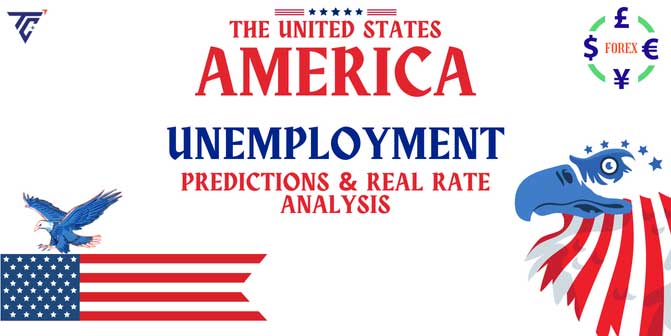The US unemployment rate predictions in 2025 are an important economic indicator that shapes job markets, financial stability, and broader economic health. It influences consumer spending, government policies, and the overall economic outlook. As we enter 2025, understanding the US unemployment rate predictions 2025 is essential for assessing the nation’s trend.
Understanding economic indicators is crucial for making informed investment decisions. Learn more about qualitative data analysis in Stocks and how it helps assess market trends and economic conditions.
This analysis will explore how many people gets unemployed in the US 2025 , real unemployment rates, key factors driving employment trends, and a comparison of 2024 vs. 2025 unemployment rates to provide a comprehensive view of the labor market.
Quick insights
Factors influencing 2025 unemployment predictions
Several macroeconomic and policy-driven factors will shape the prediction of unemployment rate in 2025 US. Factors influencing unemployment predictions are given below:
- Real GDP (Gross Domestic product) growth
- Federal Reserve Bank’s interest rate policy
- Inflation and price index trends
- Technological advancement
- Government policy
Real GDP (Gross Domestic Product) growth
- Real GDP growth is a key indicator of economic expansion, indicating a growing economy with increased labor demand and job growth in 2025.
- A recession refers to a weakening of the economy, which leads to increased unemployment.
- In 2025, policymakers will need to balance economic expansion and reduce the risk of unemployment to ensure a stable labor market.
Federal Reserve Bank’s interest rate policy
- The Federal Reserve Bank significantly influences unemployment trends by manipulating interest rates.
- Low rates encourage business expansion and investment, reducing unemployment.
- Due to ongoing concerns about inflation, the Federal Reserve Bank’s decisions on interest rates may adjust by several basis points, influencing the labor market.
Inflation and price index trends
- Inflation, as seen in price index trends, significantly affects consumer purchasing power and business activity.
- Rising prices increase costs, reduce consumer spending, and lead businesses to reduce production and lay off workers, further reducing profits.
- This could lead to a slowdown in job growth and increased unemployment, underscoring the need for effective inflation management for a healthy labor market.
Technological advancement
- Technological advances, especially automation and AI, are transforming the labor market.
- AI is creating new opportunities in development and data science, but it is also displacing workers in traditional sectors such as manufacturing and customer service.
- The current job market is characterized by a gap between available positions and employee skills, which will affect the real unemployment rate.
- Technology is revolutionizing industries, allowing traders to use advanced tools in the financial markets. Discover the best Forex trading apps of 2025 for modern traders.
Government policy
- Government policies significantly affect employment rates, while fiscal policies affect business investment and infrastructure spending, which are likely to create jobs.
- Unemployment benefits and political changes, such as those associated with Donald Trump, create uncertainty about future policy directions that will affect labor force participation.
- The interaction between these factors is crucial for predicting employment trends.
Comparative analysis: 2024 vs. 2025 unemployment rates
The U.S. unemployment rate serves as a key indicator of economic health, reflecting the balance between labor market demand and supply. Here is a comparative analysis of unemployment rates between 2024 and 2025.
Unemployment rates in 2024
What was the unemployment rate in 2024 USA? According to the Bureau of Labor Statistics, in the quarter of 2024, the US labor market showed some adaptability, with the unemployment rate experiencing only minor fluctuations.
- In November, the rate stabilized at 4.2%, representing approximately 7.1 million unemployed individuals, reflecting ongoing changes in the post-pandemic economy.
- However, by December, there was a slight improvement, with the unemployment rate falling to 4.1% and the number of unemployed people falling to approximately 6.9 million.
- This slight downward trend indicates a gradual tightening in the labor market, which could indicate increased job creation or a reduction in labor force participation.
- The economy maintained a delicate balance during this period, guided by inflation, monetary policy, and developed labor dynamics, despite minor fluctuations.
Unemployment rates in 2025
The Bank of St. Louis projects unemployment to range between 4.1% and 4.5% depending on GDP growth and labor market trends.
- In January 2025, the unemployment rate stabilized at 4.0%, representing approximately 6.85 million unemployed individuals, reflecting ongoing adjustments in the economy.
- However, by February 2025, there was a slight deterioration, with the unemployment rate rising to 4.1% and the number of unemployed people increasing to approximately 7.05 million.
- This upward trend indicates a loosening labor market, which could signal decreased job creation, an increase in labor force participation, or a combination of both factors.
- The economy experienced a slight setback during this period, influenced by rising inflation, monetary policy adjustments, and shifting labor dynamics, despite efforts to maintain stability.
Understanding the real and natural unemployment rates
Understanding both the real unemployment rate (U-6) and the natural unemployment rate helps assess workforce participation and long-term economic stability.
Real unemployment rate
- The real unemployment rate in the United States is officially known as the U-6 measure.
- It provides a comprehensive view of the labor shortage by including the total unemployed, people who are partially engaged in the labor force, and those who are working part-time for economic reasons.
- As of February 2025, the U-6 unemployment rate had risen to 8.0% from 7.5% in January, marking the highest level since October 2021.
- This percentage point’s increase indicates a growing number of individuals facing unemployment or difficulty obtaining full-time employment.
Natural unemployment rate
What is the natural unemployment rate in the US? The natural unemployment rate in the United States is officially estimated to be around 4.25% as of 2025.
- It provides a basic view of the labor market by accounting for factors such as frictional and structural unemployment, excluding cyclical unemployment, which fluctuates with the business cycle.
- As of 2025, this estimated natural rate is close to the actual unemployment rate of 4.1% reported in February.
- This indicates that the labor market is operating near full capacity with minimal cyclical unemployment.
- This closeness indicates a healthy labor market with low unemployment, which is not putting significant pressure on inflation.
Future outlook: Employment trends beyond 2025
Key predictions for the US labor market details are given below:
- Technology and AI growth: Technology and AI are expected to significantly change employment trends by 2025, creating new jobs in AI development, data science, cybersecurity, and robotics, requiring digital literacy and adaptability. Learn more about online Forex trading and how it works to understand how technology is reshaping trading strategies in the modern economy.
- Service sector expansion: The service sector, including healthcare, finance, and education, is predicted to remain a significant employment source beyond 2025, driven by aging global populations, automation, and STEM (Science, technology, engineering, and mathematics) fields.
- Interest rate adjustments: The Reserve Bank of St, interest rate adjustments can significantly affect job availability, borrowing costs, consumer spending, business investment, and currency value. It affects export-oriented industries and employment opportunities.
- Recession risks: Economic analysis experts predict a mild recession, potentially increasing unemployment, while others anticipate sustained growth due to a strong job market, consumer spending, and technological advancements.
Conclusion
The US job market in 2025 will be influenced by various factors including the Federal Reserve’s interest rate management, GDP growth, inflation, and technological advancements. Although unemployment rates are expected to remain stable, external factors like economic policy shifts and automation’s impact could reshape the employment landscape.
Staying informed about Federal Reserve policy decisions, economic analyses, and labor market dynamics is crucial for understanding future employment trends. Additionally, understanding bullish vs. bearish market differences can help investors and job seekers anticipate market shifts that may impact employment opportunities.
Pro tip
Understanding these trends can help businesses, policymakers, and job seekers make informed decisions. Our best Forex broker provides a broker finder tool to help users discover the best brokers for their trading needs. Explore a range of investment options, including Stocks, Banking, Finance, and Crypto. Share your thoughts in the comments!









